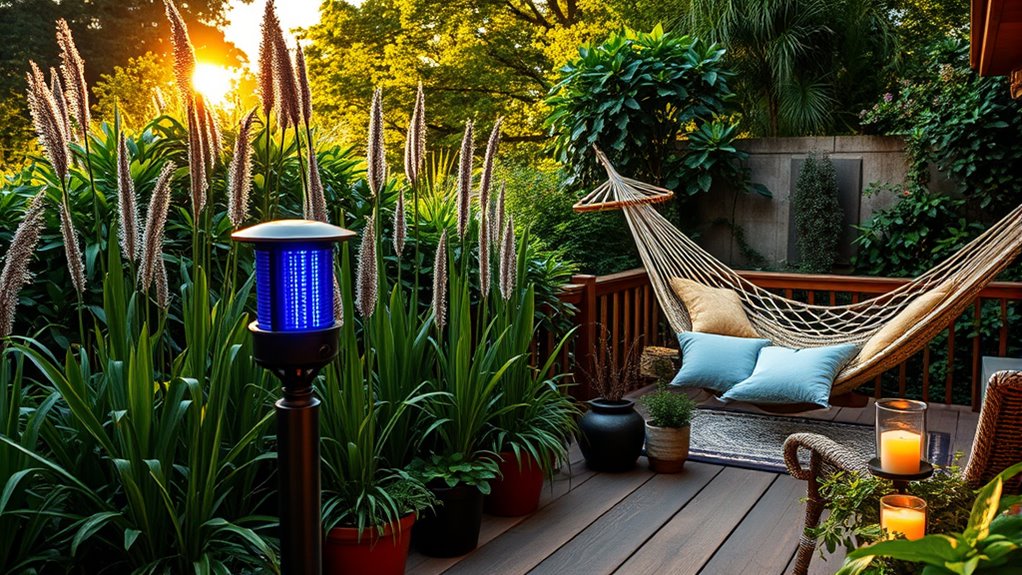To keep your backyard mosquito-free, eliminate standing water by emptying containers, fixing drainage, and clearing debris. Install physical barriers like screens and mesh on doors and windows. Incorporate mosquito-repellent plants such as citronella, lavender, and basil around seating areas. Use safe repellents when outdoors and maintain your yard by trimming grass, bushes, and weeds regularly. Combining these techniques creates a very effective defense—keep going to discover even more ways to protect your space.
Key Takeaways
- Regularly eliminate standing water sources and maintain proper drainage to prevent mosquito breeding.
- Install physical barriers like screens on doors, windows, and patio enclosures to keep mosquitoes out.
- Use mosquito-repellent plants such as citronella, lavender, and basil around seating and pathways.
- Encourage natural predators like bats, dragonflies, and certain fish to control mosquito larvae.
- Incorporate outdoor lighting with yellow or amber bulbs to reduce mosquito attraction at night.
Remove Standing Water to Eliminate Breeding Sites
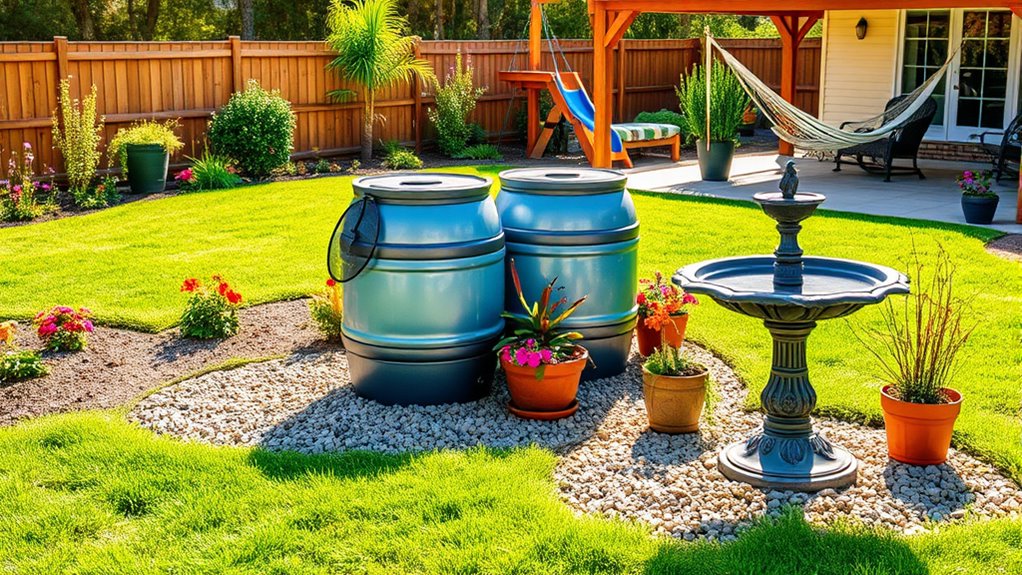
Since standing water provides an ideal breeding ground for mosquitoes, removing it is one of the most effective ways to reduce their population in your backyard. Check your yard regularly for containers, buckets, or planters that collect water, and empty or overturn them. Verify proper water drainage by fixing any areas where water pools, such as low spots in your lawn or clogged gutters. Debris removal is also vital; leaves, trash, and organic matter can hold water and create breeding sites. Clear out clogged drains and remove any items that trap water. Consider using self-watering plant pots to prevent overwatering and eliminate stagnant water sources around your yard. By keeping your yard dry and free of debris, you eliminate mosquito breeding sites, helping to protect your outdoor space from these pests.
Use Natural Predators to Control Mosquito Populations

Introducing natural predators into your yard can help reduce mosquito numbers effectively. Beneficial insects like dragonflies and certain fish feed on mosquito larvae, keeping populations in check. To support these predators, you’ll want to create habitats that attract and sustain them around your backyard. Additionally, understanding AI’s impact on privacy and regulation can help you implement these eco-friendly strategies responsibly and ethically.
Beneficial Insects for Mosquitoes
Beneficial insects can be natural allies in your fight against mosquitoes, as they prey on mosquito larvae and adults. These beneficial insects, such as certain types of beetles, dragonflies, and damselflies, act as natural predators that help keep mosquito populations in check. For example, larval beetles feed on mosquito larvae in standing water, reducing the number of mosquitoes reaching adulthood. Dragonflies, often called “mosquito hawks,” hunt adult mosquitoes mid-flight, providing effective control. By encouraging these beneficial insects around your yard, you create a natural barrier against mosquito breeding and biting. Creating habitats that attract and sustain natural predators can considerably decrease mosquito numbers without the use of chemicals. Relying on beneficial insects is a sustainable, eco-friendly way to maintain a mosquito-free backyard. Additionally, maintaining standing water removal helps ensure these beneficial insect populations thrive and continue their natural pest control.
Maintaining Predator Habitats
Maintaining habitats that attract natural mosquito predators is a highly effective way to control mosquito populations in your yard. By encouraging animals like bats and birds, you create a natural balance. Installing bat habitats encourages these nocturnal hunters to roost nearby, reducing mosquito numbers. Bird nesting sites, such as birdhouses and shrubs, attract insectivorous birds that feed on mosquito larvae and adults. To help you get started, here’s a quick overview:
| Habitat Type | Benefits |
|---|---|
| Bat habitats | Nighttime mosquito control |
| Bird nesting | Daytime mosquito reduction |
Creating these habitats provides a sustainable, chemical-free method of keeping mosquitoes at bay while supporting local wildlife.
Install Physical Barriers Like Screens and Nets

Installing physical barriers such as screens and nets is one of the most effective ways to keep mosquitoes out of your backyard. Start by ensuring your home has sturdy screen doors and window screens that fit tightly, preventing gaps where mosquitoes can enter. Repair or replace torn or damaged screens promptly to maintain a barrier. Consider adding mesh screens to porch openings or outdoor seating areas to enjoy fresh air without risking mosquito bites. When installing screens, make sure they are fine-mesh to block even small mosquitoes. Keep doors and windows closed when not in use, especially during dawn and dusk when mosquitoes are most active. Properly installed screens and nets can also help prevent the entry of other insects, creating a more comfortable outdoor environment. These simple steps create a physical barrier that considerably reduces mosquito entry, allowing you to enjoy your backyard mosquito-free.
Incorporate Mosquito-Repellent Plants Into Your Garden
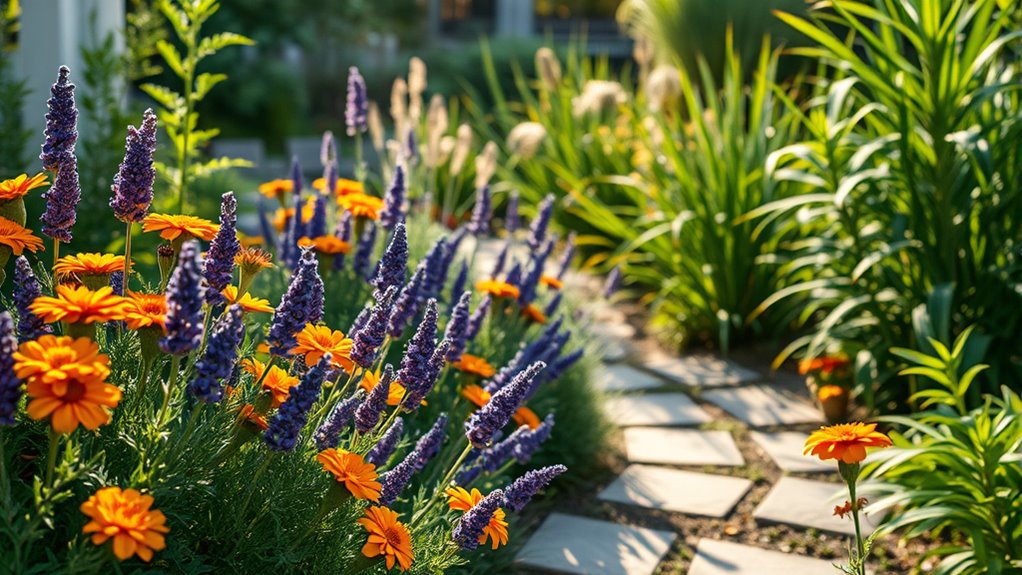
Adding mosquito-repellent plants to your garden is an effective way to keep pests at bay. To get the best results, select plants like citronella, lavender, or basil and place them strategically around your yard. Regular maintenance guarantees these plants stay healthy and continue providing natural protection. Incorporating plant-based pest control methods can further enhance your garden’s defenses against mosquitoes.
Choose Effective Plant Varieties
Incorporating mosquito-repellent plants into your garden is an effective way to naturally deter these pests. Choose plant varieties known for their mosquito-repelling properties, such as native shrubs and flowering herbs. Native shrubs like cedar and eucalyptus emit scents that mosquitoes dislike, while flowering herbs like citronella, basil, and lavender add beauty and function. Selecting the right plants guarantees your garden remains attractive and pest-free. Consider mixing these with other native plants for a sustainable, eco-friendly approach. To further enhance your strategy, research Cost-Effective Strategies for Asset Division to optimize your resources.
Plant Placement Tips
Strategic placement of mosquito-repellent plants can substantially enhance your garden’s defenses against pests. To maximize their effectiveness, focus on native plant selection, choosing varieties that thrive in your climate and naturally repel mosquitoes. Incorporate these plants around key areas like seating zones, pathways, and water features to create pest barriers. During garden layout planning, place taller plants near shaded or humid spots where mosquitoes gather, and cluster repellent plants to boost their protective effect. Positioning plants thoughtfully guarantees they’re accessible for maintenance and harvesting, while also providing continuous pest control. Keep in mind that the right placement not only improves mosquito deterrence but also complements your garden’s aesthetic. Proper plant placement ensures your backyard remains both beautiful and mosquito-free.
Maintenance for Longevity
To guarantee your mosquito-repellent plants provide ongoing protection, regular maintenance is essential. Keep your garden thriving by trimming dead leaves and ensuring healthy growth. Use pest control sprays sparingly to avoid harming beneficial insects. Incorporate landscape lighting strategically to deter mosquitoes at night while highlighting your plants’ beauty. Consistent watering and fertilizing promote robust growth, enhancing their natural repellency. Monitor for pests or disease and address issues immediately. Regularly check plant health, trimming when necessary to prevent overgrowth. Proper space utilization and organization in your garden can also help reduce mosquito breeding sites by eliminating standing water and clutter. Here’s a quick overview:
| Task | Frequency | Tips |
|---|---|---|
| Pruning | Weekly | Remove dead or damaged leaves |
| Pest control sprays | Monthly | Use natural options when possible |
| Watering | Every 2-3 days | Keep soil moist, not soaked |
| Fertilizing | Every 6 weeks | Use organic fertilizer |
| Landscape lighting | As needed | Position to maximize effect |
Apply Safe and Effective Mosquito Repellents
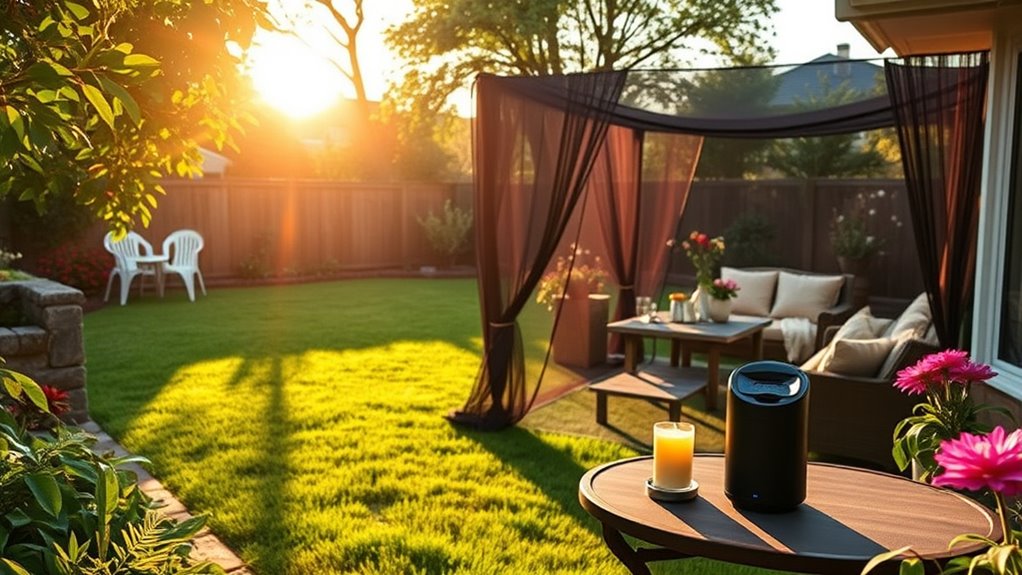
Applying safe and effective mosquito repellents is essential for protecting yourself during outdoor activities. You want to enjoy nature without worrying about bites or disease transmission. Choose repellents with proven ingredients like DEET, picaridin, or IR3535, and always follow chemical precautions. Your personal safety depends on proper application—avoid contact with eyes and mouth, and wash hands afterward. Reapply as directed, especially if sweating or swimming. Using a combination of repellents and physical barriers can provide enhanced protection for outdoor safety.
Protect yourself with proven mosquito repellents like DEET, picaridin, or IR3535, and apply safely for outdoor safety.
- Feel confident knowing you’re taking control of your environment
- Protect loved ones from mosquito-borne illnesses
- Reduce the risk of allergic reactions or skin irritation
- Enjoy outdoor moments without constant worry
- Be proactive in safeguarding your health and peace of mind
Maintain Your Yard to Reduce Mosquito Habitats
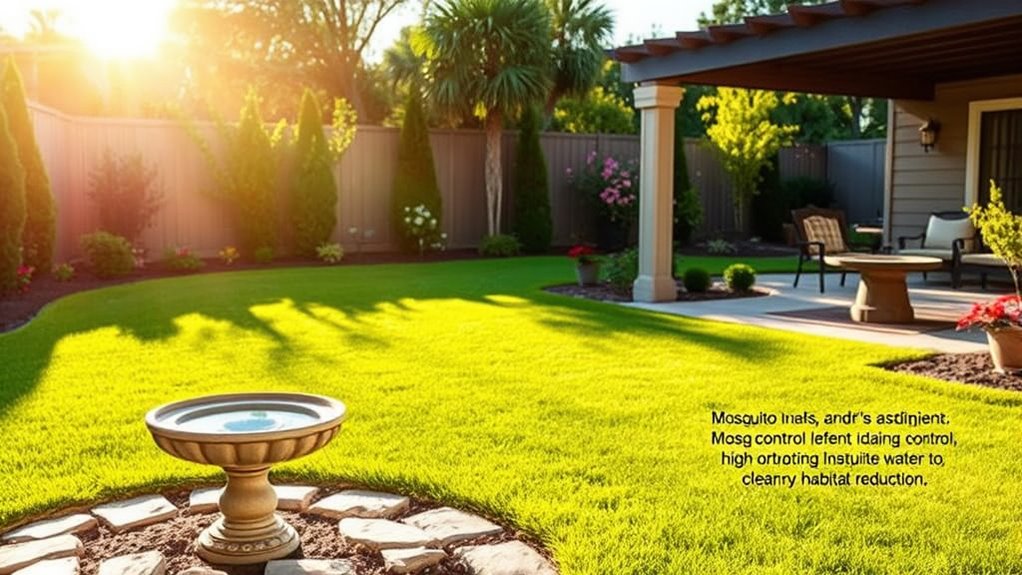
Keeping your yard well-maintained plays a vital role in reducing mosquito populations. Regular lawn mowing removes tall grass and weeds that serve as resting spots for mosquitoes. Keep your grass at a short, even height to make it less inviting. Eliminating standing water is essential, but maintaining your yard also involves managing landscape lighting, which can attract mosquitoes at night. Use yellow or amber outdoor lights instead of bright white bulbs, as they attract fewer insects. Trim bushes and shrubs to improve airflow and reduce shaded, damp areas where mosquitoes breed. By keeping your yard tidy, well-lit, and free of clutter, you create an environment less conducive to mosquito habitats, helping you enjoy a safer, more comfortable outdoor space. Properly managing mosquito breeding sites can further decrease local populations and enhance outdoor comfort.
Consider Environmental Modifications for Long-Term Relief
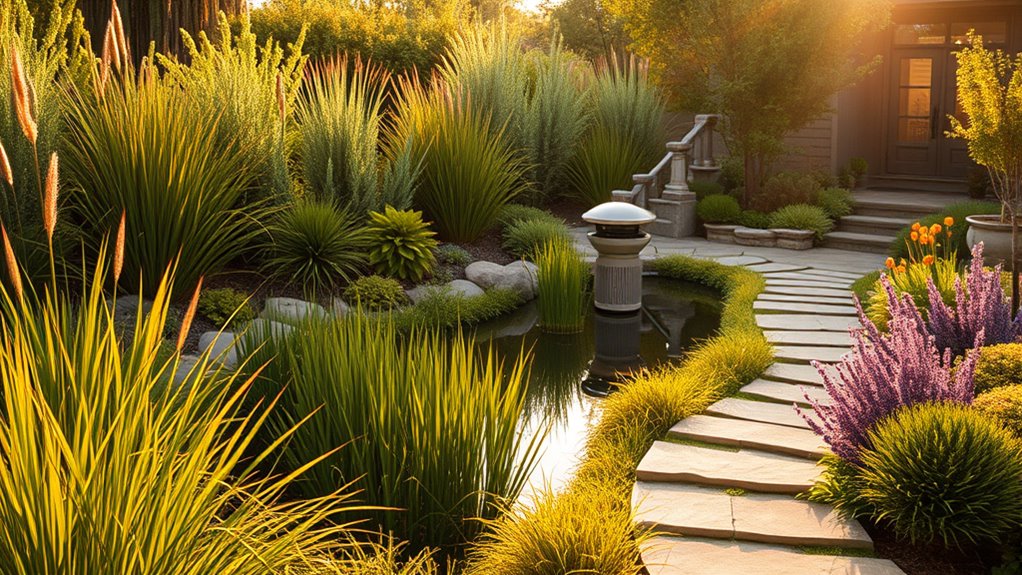
Implementing environmental modifications can provide lasting relief from mosquitoes by disrupting their breeding cycles. A thoughtful landscape redesign creates barriers, drains standing water, and reduces shady hiding spots. Incorporate outdoor lighting that deters mosquitoes without disturbing your outdoor ambiance. Consider these strategies:
- Transform your yard into a mosquito-unfriendly zone with tall grass removal
- Eliminate puddles and standing water sources promptly
- Use outdoor lighting to repel mosquitoes while illuminating your space
- Plant mosquito-repellent vegetation like citronella or lavender
- Install screens or barriers around decks and patios
Frequently Asked Questions
Are There Any Chemical Treatments Safe for Pets and Children?
When considering chemical treatments, you wonder if they’re safe for pets and children. You should look for pet-safe treatments that are specifically formulated to minimize risks, and natural repellents like citronella or essential oils can be good alternatives. Always read labels carefully and consult your veterinarian before applying any product. Using these options helps protect your loved ones while effectively reducing mosquitoes in your backyard.
How Often Should I Inspect My Yard for New Mosquito Breeding Sites?
Think of your yard as a garden of potential mosquito traps. You should inspect it weekly, especially after heavy rains, to catch new breeding sites early. Regular breeding site monitoring helps prevent mosquito populations from taking hold. By staying vigilant and maintaining a consistent inspection frequency, you’ll cut off their breeding grounds before they multiply, creating a safer, more enjoyable outdoor space for you and your family.
Can Mosquito Repellents Harm Beneficial Insects Like Bees?
You might wonder if mosquito repellents harm beneficial insects like bees. Natural repellents, such as citronella and eucalyptus, are generally insect-friendly, making them safer choices for your garden. When you create insect-friendly gardens with plants that naturally repel mosquitoes, you reduce the need for chemical repellents that could harm bees. Always choose repellents carefully, applying them in a way that minimizes impact on beneficial insects, and support a balanced, healthy yard.
What Time of Day Are Mosquitoes Most Active in My Area?
Mosquitoes are like night owls, most active during dusk activity, when the shadows grow long. In your area, they tend to become most aggressive at dawn and dusk, while spending the daytime resting in shaded spots. This means you’re safest from bites during late morning to early afternoon. To minimize encounters, avoid outdoor activities during peak mosquito hours, and eliminate standing water that serves as their breeding grounds.
Are There Any Legal Restrictions on Installing Mosquito Netting or Barriers?
You might wonder if installing mosquito netting or barriers is legally permitted. Check your local regulations and property restrictions first, as some areas have rules governing modifications to your property. Typically, you can install netting without issue, but certain types or placements may require permits or approval. Always review local laws or consult your homeowners’ association to ensure your mosquito control measures adhere to regulations, avoiding potential fines or conflicts.
Conclusion
By following these simple yet powerful strategies, you can turn your backyard into a mosquito-free paradise—where not even a single bite dares to intrude! Imagine a yard so protected, mosquitoes would need a spaceship to find their way in. With consistent effort, you’ll create a fortress of safety, transforming your outdoor space into a serene sanctuary that even the most persistent pests can’t breach. Say goodbye to bites and hello to endless outdoor enjoyment!
